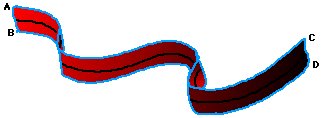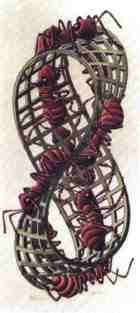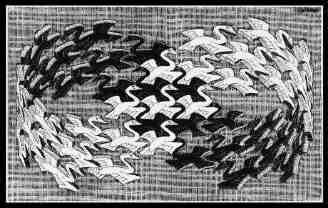Saturday, February 19, 2005
An Interesting Analogy
This morning I was reading a piece by my friend David Salisbury over at the CATO Institute on a New York court case regarding school spending and I was having trouble getting past the first sentence:
Not knowing waht a Mobius Strip was I decided to google it. This is what I found:
The M�bius Strip
1. Start with a long rectangle (ABCD) made of paper.

(ABCD)
2. Give the rectangle a half twist.
3. Join the ends so that A is matched with D and B is matched with C.

(A-D)(B-C)
This curious surface is called a M�bius Strip or M�bius Band, named after August Ferdinand M�bius, a nineteenth century German mathematician and astronomer, who was a pioneer in the field of topology. M�bius, along with his better known contemporaries, Riemann, Lobachevsky and Bolyai, created a non-Euclidean revolution in geometry.
M�bius strips have found a number of surprising applications that exploit a remarkable property they possess: one-sidedness. Joining A to C and B to D (no half twist) would produce a simple belt-shaped loop with two sides and two edges -- impossible to travel from one side to the other without crossing an edge. But, as a result of the half twist, the M�bius Strip has only one side and one edge!
To demonstrate this, (1) start midway between the "edges" of a M�bius Strip and draw a line down its center; continue the line until you return to your starting point. Did you ever cross an edge? (2) Next, hold the edge of a M�bius Strip against the tip of a felt-tipped highlighter pen. Color the edge of the M�bius Strip by holding the highlighter still and just rotating the Mobius Strip around. Were you able to color the entire edge? (3) Now, with scissors cut the Mobius Strip along the center line that you drew. Then draw a center line around the resulting band, and cut along it. Did you predict what would happen?
Giant M�bius Strips have been used as conveyor belts (to make them last longer, since "each side" gets the same amount of wear) and as continuous-loop recording tapes (to double the playing time). In the 1960's Sandia Laboratories used M�bius Strips in the design of versatile electronic resistors. Free-style skiers have christened one of their acrobatic stunts the M�bius Flip.
The famous artist, M.C. Escher, used mathematical themes in some of his work, including a M�bius parade of ants.

M.C. Escher

His flight of swans looks like it might be a M�bius Strip, but it's not. Can you see why not?

M.C. Escher 2

Martin Gardner wrote an amusing short story based on the M�bius Strip called "The No-sided Professor," which you can find in Fantasia Mathematica, a book edited by Clifton Fadiman.
PermaLink | 7:24 AM |
|
The back-and-forth that resulted in Monday's decision by New York state Supreme
Court Justice Leland DeGrasse was several years in coming, and included more
twists than a Mobius Strip, but the issues were fairly straightforward.
Not knowing waht a Mobius Strip was I decided to google it. This is what I found:
The M�bius Strip
1. Start with a long rectangle (ABCD) made of paper.

(ABCD)

2. Give the rectangle a half twist.
3. Join the ends so that A is matched with D and B is matched with C.

(A-D)(B-C)

This curious surface is called a M�bius Strip or M�bius Band, named after August Ferdinand M�bius, a nineteenth century German mathematician and astronomer, who was a pioneer in the field of topology. M�bius, along with his better known contemporaries, Riemann, Lobachevsky and Bolyai, created a non-Euclidean revolution in geometry.
M�bius strips have found a number of surprising applications that exploit a remarkable property they possess: one-sidedness. Joining A to C and B to D (no half twist) would produce a simple belt-shaped loop with two sides and two edges -- impossible to travel from one side to the other without crossing an edge. But, as a result of the half twist, the M�bius Strip has only one side and one edge!
To demonstrate this, (1) start midway between the "edges" of a M�bius Strip and draw a line down its center; continue the line until you return to your starting point. Did you ever cross an edge? (2) Next, hold the edge of a M�bius Strip against the tip of a felt-tipped highlighter pen. Color the edge of the M�bius Strip by holding the highlighter still and just rotating the Mobius Strip around. Were you able to color the entire edge? (3) Now, with scissors cut the Mobius Strip along the center line that you drew. Then draw a center line around the resulting band, and cut along it. Did you predict what would happen?
Giant M�bius Strips have been used as conveyor belts (to make them last longer, since "each side" gets the same amount of wear) and as continuous-loop recording tapes (to double the playing time). In the 1960's Sandia Laboratories used M�bius Strips in the design of versatile electronic resistors. Free-style skiers have christened one of their acrobatic stunts the M�bius Flip.
The famous artist, M.C. Escher, used mathematical themes in some of his work, including a M�bius parade of ants.

M.C. Escher

His flight of swans looks like it might be a M�bius Strip, but it's not. Can you see why not?

M.C. Escher 2

Martin Gardner wrote an amusing short story based on the M�bius Strip called "The No-sided Professor," which you can find in Fantasia Mathematica, a book edited by Clifton Fadiman.
